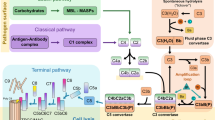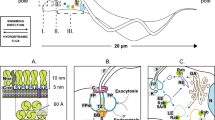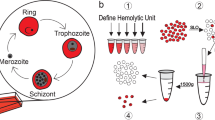Abstract
African trypanosomes (the prototype of which is Trypanosoma brucei brucei) are protozoan parasites that infect a wide range of mammals. Human blood, unlike the blood of other mammals, has efficient trypanolytic activity, and this needs to be counteracted by these parasites. Resistance to this activity has arisen in two subspecies of Trypanosoma brucei — Trypanosoma brucei rhodesiense and Trypanosoma brucei gambiense — allowing these parasites to infect humans, and this results in sleeping sickness in East Africa and West Africa, respectively. Study of the mechanism by which T. b. rhodesiense escapes lysis by human serum led to the identification of an ionic-pore-forming apolipoprotein — known as apolipoprotein L1 — that is associated with high-density-lipoprotein particles in human blood. In this Opinion article, we argue that apolipoprotein L1 is the factor that is responsible for the trypanolytic activity of human serum.
This is a preview of subscription content, access via your institution
Access options
Subscribe to this journal
Receive 12 print issues and online access
$209.00 per year
only $17.42 per issue
Buy this article
- Purchase on Springer Link
- Instant access to full article PDF
Prices may be subject to local taxes which are calculated during checkout





Similar content being viewed by others
References
Blum, M. L. et al. A structural motif in the variant surface glycoproteins of Trypanosoma brucei. Nature 362, 603–609 (1993).
Cross, G. A. M. Antigenic variation in trypanosomes. Proc. R. Soc. Lond. B 202, 55–72 (1978).
Barry, J. D. The relative significance of mechanisms of antigenic variation in African trypanosomes. Parasitol. Today 13, 212–218 (1997).
Borst, P. Antigenic variation and allelic exclusion. Cell 109, 5–8 (2002).
Pays, E., Vanhamme, L. & Pérez-Morga, D. Antigenic variation in Trypanosoma brucei: facts, challenges and mysteries. Curr. Opin. Microbiol. 7, 369–374 (2004).
Laveran, A. & Mesnil, F. in Trypanosomes et Trypanosomiases 126–183 (Libraires de l'Académie de Médecine, Paris, 1912) (in French).
Seed, J. R., Sechelski, J. B. & Loomis, M. R. A survey for a trypanocidal factor in primate sera. J. Protozool. 37, 393–400 (1990).
Poelvoorde, P., Vanhamme, L., Van Den Abbeele, J., Switzer, W. M. & Pays, E. Distribution of apolipoprotein L-I and trypanosome lytic activity among primate sera. Mol. Biochem. Parasitol. 134, 155–157 (2004).
Lugli, E. B., Pouliot, M., Portela, M. P., Loomis, M. R. & Raper, J. Characterization of primate trypanosome lytic factors. Mol. Biochem. Parasitol. 138, 9–20 (2004).
Rifkin, M. R. Identification of the trypanocidal factor in normal human serum: high density lipoprotein. Proc. Natl Acad. Sci. USA 75, 3450–3454 (1978).
Rifkin, M. R. Role of phospholipids in the cytotoxic action of high density lipoprotein on trypanosomes. J. Lipid Res. 32, 639–647 (1991).
Hajduk, S. L. et al. Lysis of Trypanosoma brucei by a toxic subspecies of human high-density lipoprotein. J. Biol. Chem. 264, 5210–5217 (1989).
Gillett, M. P. & Owen, J. S. Trypanosoma brucei brucei: differences in the trypanocidal activity of human plasma and its relationship to the level of high density lipoproteins. Trans. R. Soc. Trop. Med. Hyg. 85, 612–616 (1991).
Gillett, M. P. & Owen, J. S. Comparison of the cytolytic effects in vitro on Trypanosoma brucei brucei of plasma, high density lipoproteins, and apolipoprotein A-I from hosts both susceptible (cattle and sheep) and resistant (human and baboon) to infection. J. Lipid Res. 33, 513–523 (1992).
Lorenz, P., Owen, J. S. & Hassall, D. G. Human serum resistant Trypanosoma brucei rhodesiense accumulates similar amounts of fluorescently-labelled trypanolytic human HDL3 particles as human serum sensitive T. b. brucei. Mol. Biochem. Parasitol. 74, 113–118 (1995).
Hager, K. M. et al. Endocytosis of a cytotoxic human high density lipoprotein results in disruption of acidic intracellular vesicles and subsequent killing of African trypanosomes. J. Cell Biol. 126, 155–167 (1994).
Lorenz, P., Barth, P. E., Rudin, W. & Betschart, B. Importance of acidic intracellular compartments in the lysis of Trypanosoma brucei brucei by normal human serum. Trans. R. Soc. Trop. Med. Hyg. 88, 487–488 (1994).
Ortiz-Ordonez, J. C., Sechelski, J. B. & Seed, J. R. Mechanism of lysis of Trypanosoma brucei gambiense by human serum. J. Parasitol. 80, 924–930 (1994).
Hager, K. M. & Hajduk, S. L. Mechanism of resistance of African trypanosomes to cytotoxic human HDL. Nature 385, 823–826 (1997).
Shimamura, M., Hager, K. M. & Hajduk, S. L. The lysosomal targeting and intracellular metabolism of trypanosome lytic factor by Trypanosoma brucei brucei. Mol. Biochem. Parasitol. 115, 227–237 (2001).
Vanhamme, L. & Pays, E. The trypanosome lytic factor of human serum and the molecular basis of sleeping sickness. Int. J. Parasitol. 34, 887–898 (2004).
Garcia-Salcedo, J. A. et al. A differential role for actin during the life cycle of Trypanosoma brucei. EMBO J. 23, 780–789 (2004).
Green, H. P., del Pilar Molina Portela, M., St Jean, E. N., Lugli, E. B. & Raper, J. Evidence for a Trypanosoma brucei lipoprotein scavenger receptor. J. Biol. Chem. 278, 422–427 (2003).
Smith, A. B, Esko, J. D. & Hajduk, S. L. Killing of trypanosomes by the human haptoglobin-related protein. Science 268, 284–286 (1995).
Raper, J., Nussenzweig, V. & Tomlinson, S. The main lytic factor of Trypanosoma brucei brucei in normal human serum is not high density lipoprotein. J. Exp. Med. 183, 1023–1029 (1996).
Tomlinson, S., Muranjan, M., Nussenzweig, V. & Raper, J. Haptoglobin-related protein and apolipoprotein AI are components of the two trypanolytic factors in human serum. Mol. Biochem. Parasitol. 86, 117–120 (1997).
Muranjan, M., Nussenzweig, V. & Tomlinson, S. Characterization of the human serum trypanosome toxin, haptoglobin-related protein. J. Biol. Chem. 273, 3884–3887 (1998).
Rifkin, M. R. Trypanosoma brucei: cytotoxicity of host high-density lipoprotein is not mediated by apolipoprotein A-I. Exp. Parasitol. 72, 216–218 (1991).
Owen, J. S., Gillett, M. P. & Hughes, T. E. Transgenic mice expressing human apolipoprotein A-I have sera with modest trypanolytic activity in vitro but remain susceptible to infection by Trypanosoma brucei brucei. J. Lipid Res. 33, 1639–1646 (1992).
Tomlinson, S. et al. High-density-lipoprotein-independent killing of Trypanosoma brucei by human serum. Mol. Biochem. Parasitol. 70, 131–138 (1995).
Smith, A. B. & Hajduk, S. L. Identification of haptoglobin as a natural inhibitor of trypanocidal activity in human serum. Proc. Natl Acad. Sci. USA 92, 10262–10266 (1995).
Raper, J., Nussenzweig, V. & Tomlinson, S. Lack of correlation between haptoglobin concentration and trypanolytic activity of normal human serum. Mol. Biochem. Parasitol. 76, 337–338 (1996).
Raper, J., Fung, R., Ghiso, J., Nussenzweig, V. & Tomlinson, S. Characterization of a novel trypanosome lytic factor from human serum. Infect. Immun. 67, 1910–1916 (1999).
Barker, C., Barbour, K. W., Berger, F. G. & Hajduk, S. L. Activity of human trypanosome lytic factor in mice. Mol. Biochem. Parasitol. 117, 129–136 (2001).
McEvoy, S. M. & Maeda, N. Complex events in the evolution of the haptoglobin gene cluster in primates. J. Biol. Chem. 263, 15740–15747 (1988).
Drain, J., Bishop, J. R. & Hajduk, S. L. Haptoglobin-related protein mediates trypanosome lytic factor binding to trypanosomes. J. Biol. Chem. 276, 30254–30260 (2001).
Bishop, J. R., Shimamura, M. & Hajduk, S. L. Insight into the mechanism of trypanosome lytic factor-1 killing of Trypanosoma brucei brucei. Mol. Biochem. Parasitol. 118, 33–40 (2001).
Molina Portela, M. P., Raper, J. & Tomlinson, S. An investigation into the mechanism of trypanosome lysis by human serum factors. Mol. Biochem. Parasitol. 110, 273–282 (2000).
Van Meirvenne, N., Magnus, E. & Janssens, P. G. The effect of normal human serum on trypanosomes of distinct antigenic type (ETat 1 to 12) isolated from a strain of Trypanosoma brucei rhodesiense. Ann. Soc. Belg. Med. Trop. 56, 55–63 (1976).
Xong, H. V. et al. A VSG expression site-associated gene confers resistance to human serum in Trypanosoma rhodesiense. Cell 95, 839–846 (1998).
Pays, E., Lips, S., Nolan, D., Vanhamme, L. & Pérez-Morga, D. The VSG expression sites of Trypanosoma brucei: multipurpose tools for the adaptation of the parasite to mammalian hosts. Mol. Biochem. Parasitol. 114, 1–16 (2001).
De Greef, C., Imberechts, H., Matthyssens, G., Van Meirvenne, N. & Hamers, R. A gene expressed only in serum-resistant variants of Trypanosoma brucei rhodesiense. Mol. Biochem. Parasitol. 36, 169–176 (1989).
De Greef, C. & Hamers, R. The serum resistance-associated (SRA) gene of Trypanosoma brucei rhodesiense encodes a variant surface glycoprotein-like protein. Mol. Biochem. Parasitol. 68, 277–284 (1994).
Campillo, N. & Carrington, M. The origin of the serum resistance associated (SRA) gene and a model of the structure of the SRA polypeptide from Trypanosoma brucei rhodesiense. Mol. Biochem. Parasitol. 127, 79–84 (2003).
Vanhamme, L. et al. The Trypanosoma brucei reference strain TREU927/4 contains T. b. rhodesiense-specific SRA sequences, but displays a distinct phenotype of relative resistance to human serum. Mol. Biochem. Parasitol. 135, 39–47 (2004).
Milner, J. D. & Hajduk, S. L. Expression and localization of serum resistance associated protein in Trypanosoma brucei rhodesiense. Mol. Biochem. Parasitol. 104, 271–283 (1999).
Welburn, S. C. et al. Identification of human-infective trypanosomes in animal reservoir of sleeping sickness in Uganda by means of serum-resistance-associated (SRA) gene. Lancet 358, 2017–2019 (2001).
Gibson, W., Backhouse, T. & Griffiths, A. The human serum resistance associated gene is ubiquitous and conserved in Trypanosoma brucei rhodesiense throughout East Africa. Infect. Genet. Evol. 1, 207–214 (2002).
Radwanska, M. et al. The serum resistance-associated gene as a diagnostic tool for the detection of Trypanosoma brucei rhodesiense. Am. J. Trop. Med. Hyg. 67, 684–690 (2002).
Gibson, W. & Ferris, V. Conservation of the genomic location of the human serum resistance associated gene in Trypanosoma brucei rhodesiense. Mol. Biochem. Parasitol. 130, 159–162 (2003).
Gibson, W. C. The SRA gene: the key to understanding the nature of Trypanosoma brucei rhodesiense. Parasitology 131, 143–150 (2005).
Vanhamme, L. et al. Differential RNA elongation controls the variant surface glycoprotein gene expression sites of Trypanosoma brucei. Mol. Microbiol. 36, 328–340 (2000).
De Greef, C., Chimfwembe, E., Kihang' a Wabacha, J., Bajyana Songa, E. & Hamers, R. Only the serum-resistant bloodstream forms of Trypanosoma brucei rhodesiense express the serum resistance associated (SRA) protein. Ann. Soc. Belg. Med. Trop. 72 (Suppl. 1), 13–21 (1992).
Vanhamme, L. et al. Apolipoprotein L-I is the trypanosome lytic factor of human serum. Nature 422, 83–87 (2003).
Triggs, V. P. & Bangs, J. D. Glycosylphosphatidylinositol-dependent protein trafficking in bloodstream stage Trypanosoma brucei. Eukaryot. Cell 2, 76–83 (2003).
Wang, J., Böhme, U. & Cross, G. A. M. Structural features affecting variant surface glycoprotein expression in Trypanosoma brucei. Mol. Biochem. Parasitol. 128, 135–145 (2003).
Duchateau, P. N. et al. Apolipoprotein L, a new human high density lipoprotein apolipoprotein expressed by the pancreas. Identification, cloning, characterization, and plasma distribution of apolipoprotein L. J. Biol. Chem. 272, 25576–25582 (1997).
Mikkelsen, T. S. et al. Initial sequence of the chimpanzee genome and comparison with the human genome. Nature 437, 69–87 (2005).
Oli, M. W., Cotlin, L. F., Shiflett, A. M. & Hajduk, S. L. Serum resistance-associated protein blocks lysosomal targeting of trypanosome lytic factor in Trypanosoma brucei. Eukaryot. Cell 5, 132–139 (2006).
Moore, D. R. et al. Developmentally regulated sensitivity of Trypanosoma brucei brucei to the cytotoxic effects of human high-density lipoprotein. Exp. Parasitol. 81, 216–226 (1995).
Brun, R. & Jenni, L. Human serum resistance of metacyclic forms of Trypanosoma brucei brucei, T. brucei rhodesiense and T. brucei gambiense. Parasitol. Res. 73, 218–223 (1987).
Duchateau, P. N. et al. Plasma apolipoprotein L concentrations correlate with plasma triglycerides and cholesterol levels in normolipidemic, hyperlipidemic, and diabetic subjects. J. Lipid Res. 41, 1231–1236 (2000).
Mimmack, M. L. et al. Gene expression analysis in schizophrenia: reproducible up-regulation of several members of the apolipoprotein L family located in a high-susceptibility locus for schizophrenia on chromosome 22. Proc. Natl Acad. Sci. USA 99, 4680–4685 (2002).
Pérez-Morga, D. et al. Apolipoprotein L-I promotes trypanosome lysis by forming pores in lysosomal membranes. Science 309, 469–472 (2005).
Raper, J., Molina Portela, M. P., Lugli, E., Frevert, U. & Tomlinson, S. Trypanosome lytic factors: novel mediators of innate immunity. Curr. Opin. Microbiol. 4, 402–408 (2001).
Nolan, D. P. & Voorheis, H. P. Factors that determine the plasma-membrane potential in bloodstream forms of Trypanosoma brucei. Eur. J. Biochem. 267, 4615–4623 (2000).
Rifkin, M. R. Trypanosoma brucei: biochemical and morphological studies of cytotoxicity caused by normal human serum. Exp. Parasitol. 58, 81–93 (1984).
Cardoso de Almeida, M. L., Geuskens, M. & Pays, E. Cell lysis induces redistribution of the GPI-anchored variant surface glycoprotein on both faces of the plasma membrane of Trypanosoma brucei. J. Cell Sci. 112, 4461–4473 (1999).
del Pilar Molina-Portela, M., Lugli, E. B., Recio-Pinto, E. & Raper, J. Trypanosome lytic factor, a subclass of high-density lipoprotein, forms cation-selective pores in membranes. Mol. Biochem. Parasitol. 144, 218–226 (2005).
Shiflett, A. M., Bishop, J. R., Pahwa, A. K. & Hajduk, S. L. Human HDLs are platforms for the assembly of multi-component innate immune complexes. J. Biol. Chem. 280, 32578–32585 (2005).
McGwire, B. S., Olson, C. L., Tack, B. F. & Engman, D. M. Killing of African trypanosomes by antimicrobial peptides. J. Infect. Dis. 188, 146–152 (2003).
Baral, T. N. et al. Experimental therapy of African trypanosomiasis with a nanobody-conjugated human trypanolytic factor. Nature Med. 12, 580–584 (2006).
Hatada, S. et al. No trypanosome lytic activity in the sera of mice producing human haptoglobin-related protein. Mol. Biochem. Parasitol. 119, 291–294 (2002).
Stijlemans, B. et al. Efficient targeting of conserved cryptic epitopes of infectious agents by single domain antibodies. African trypanosomes as paradigm. J. Biol. Chem. 279, 1256–1261 (2004).
Monajemi, H., Fontijn, R. D., Pannekoek, H. & Horrevoets, A. J. The apolipoprotein L gene cluster has emerged recently in evolution and is expressed in human vascular tissue. Genomics 79, 539–546 (2002).
Page, N. M., Butlin, D. J., Lomthaisong, K. & Lowry, P. J. The human apolipoprotein L gene cluster: identification, classification, and sites of distribution. Genomics 74, 71–78 (2001).
Duchateau, P. N., Pullinger, C. R., Cho, M. H., Eng, C. & Kane, J. P. Apolipoprotein L gene family: tissue-specific expression, splicing, promoter regions; discovery of a new gene. J. Lipid Res. 42, 620–630 (2001).
Horrevoets, A. J. et al. Vascular endothelial genes that are responsive to tumor necrosis factor-α in vitro are expressed in atherosclerotic lesions, including inhibitor of apoptosis protein-1, stannin, and two novel genes. Blood 93, 3418–3431 (1999).
Liu, Z., Lu, H., Jiang, Z., Pastuszyn, A. & Hu, C. A. Apolipoprotein L6, a novel proapoptotic Bcl-2 homology 3-only protein, induces mitochondria-mediated apoptosis in cancer cells. Mol. Cancer Res. 3, 21–31 (2005).
Lazebnik, Y. Why do regulators of apoptosis look like bacterial toxins? Curr. Biol. 11, R767–R768 (2001).
Concha, M. I. et al. Apolipoproteins A-I and A-II are potentially important effectors of innate immunity in the teleost fish Cyprinus carpio. Eur. J. Biochem. 271, 2984–2990 (2004).
Sorensen, O., Bratt, T., Johnsen, A. H., Madsen, M. T. & Borregaard, N. The human antibacterial cathelicidin, hCAP-18, is bound to lipoproteins in plasma. J. Biol. Chem. 274, 22445–22451 (1999).
Acknowledgements
This paper is dedicated to the memory of M. Steinert. This work was supported by the Fonds National de la Recherche Scientifique (FNRS), the United Nations Children's Fund, United Nations Development Programme, World Bank, and World Health Organization Special Programme for Research and Training in Tropical Diseases (TDR), and the Interuniversity Attraction Poles Programme (Belgian Science Policy).
Author information
Authors and Affiliations
Corresponding author
Ethics declarations
Competing interests
The authors declare no competing financial interests.
Related links
Rights and permissions
About this article
Cite this article
Pays, E., Vanhollebeke, B., Vanhamme, L. et al. The trypanolytic factor of human serum. Nat Rev Microbiol 4, 477–486 (2006). https://doi.org/10.1038/nrmicro1428
Issue Date:
DOI: https://doi.org/10.1038/nrmicro1428
This article is cited by
-
APOL1 variant alleles associate with reduced risk for opportunistic infections in HIV infection
Communications Biology (2021)
-
APOL1 risk allele RNA contributes to renal toxicity by activating protein kinase R
Communications Biology (2018)
-
APOLs with low pH dependence can kill all African trypanosomes
Nature Microbiology (2017)
-
The molecular arms race between African trypanosomes and humans
Nature Reviews Microbiology (2014)
-
Lipid biology of the podocyte—new perspectives offer new opportunities
Nature Reviews Nephrology (2014)



